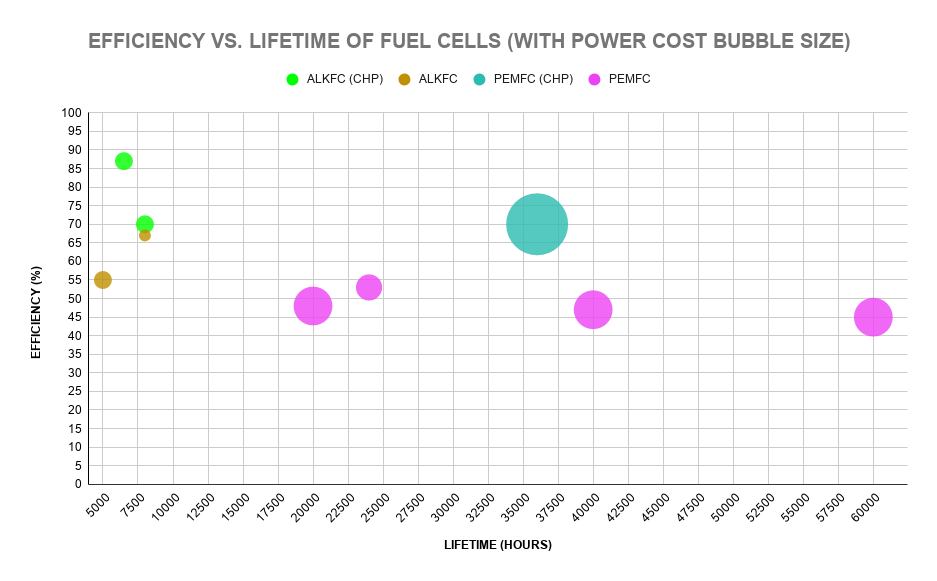The previous articles in this series focused on the power costs and operational lifetimes of hydrogen fuel cells. These factors are important, as cheaper and long-lasting fuel cells are vital for the adoption of hydrogen as a fuel. (For details of how these cells work, refer to the first article).
Cost and durability are far from being the only characteristics of fuel cells worth consideration. Here we focus on fuel cell efficiency – this is the proportion of the chemical energy stored within the hydrogen supplied to the fuel cell, that is eventually converted into usable electricity.

The graph shows the efficiency (%) of PEMFCs and ALKFCs separately, against their operational lifetime in hours. The bubble size represents the power costs of each type of cell, with larger bubbles indicating more expensive cells. We have only considered the stationary applications of PEMFCs here, as ALKFCs are currently unsuitable for automotive purposes. A variety of efficiency figures were collected from studies and market reports, which were then assigned the average lifetime and power cost figures for the technology from the previous articles (unless the source offered specific information).
When electricity is produced in fuel cells, heat and water are produced as by-products. The heat is usually lost as it escapes into the surroundings of the cell. When it can be captured for productive purposes, it increases the efficiency of the system. This is called combined heat and power (CHP), and is also commonly used when generating electricity with coal or natural gas. Another common example is the cabin heater in gasoline cars: excess heat from the engine is used to heat the passenger cabin. Because the heat would otherwise be wasted, using a car’s cabin heat does not hurt its mileage, while using its air conditioner (which cannot use waste heat from the engine), does.
To account for the efficiency boost from captured heat, the figures on the graph have been split by the presence of CHP in the system.
Within usual (non-CHP) ALKFCs, efficiencies are usually between 50-65%, while in PEMFCs the efficiencies range from 45-55%. ALKFCs tend to demonstrate slightly higher efficiencies than PEMFCs on average, and the smaller bubble size shows that they also have lower power costs. However, they are more sensitive to corrosion, and have significantly smaller operational lifetimes. Combined with their larger size, it makes them impractical for several applications, especially automotive. However, ALKFCs retain their utility for some stationary applications like backup power.
Adding CHP systems clearly increases the efficiency. In fact, ALKFCs have been shown to demonstrate nearly 87% efficiency as per one estimate (although this is yet to be seen outside a lab). PEMFCs with CHP have been known to reach nearly 70% efficiency. Not all the output is electricity, however, and CHP systems can only boost efficiency to the extent that the heat produced is actually required.
Since the lifetimes and some power costs were derived from averages, it is difficult to draw correlations between either of these factors and the efficiency from the data. For the CHP PEMFC, the cost was estimated at about $5500/kW from the source, which is about three times the average of $1880/kW. This was largely due to the cost of the additional components to capture the heat energy. Although no such estimate could be drawn for the CHP ALKFCs, it is unlikely that increasing the efficiency would translate into an equally sharp rise in costs. This is because ALKFCs generally operate at higher temperatures than PEMFCs, which means they are naturally capable of providing more usable heat energy.
The efficiency has several implications on fuel cell applications. Batteries such as lithium-ion show significantly higher efficiencies than the fuel cells. So, battery electric vehicles have managed to reach commercial scale whereas hydrogen ones have not, despite the latter having the promise of faster refueling times. However, fuel cells could play an important role in powering large buildings, if their wasted heat is harnessed through CHP systems.







